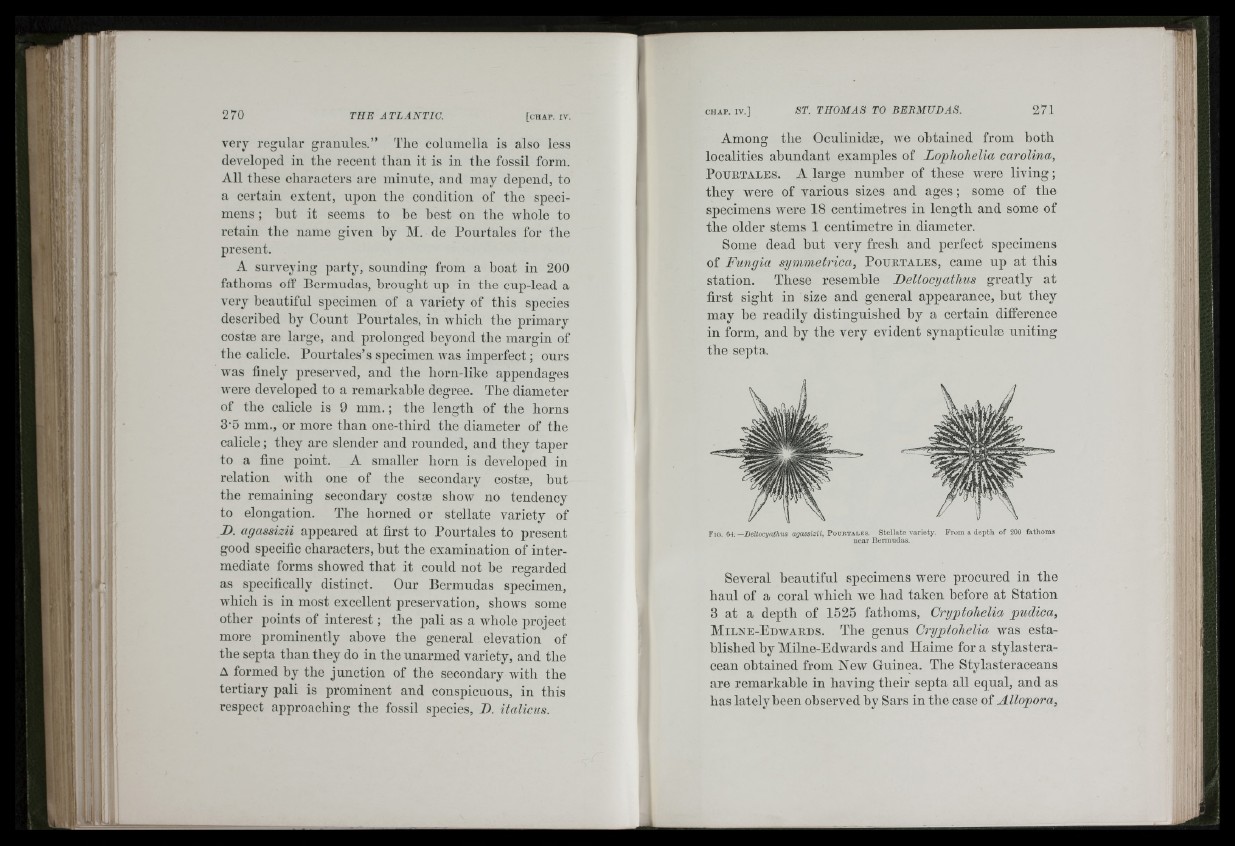
very regular granules.” The colainella is also less
developed in the recent than it is in the fossil form.
All tliese characters are minute, and may depend, to
a certain extent, npon the condition of the specimens
; but it seems to he best on the whole to
retain the name given by AI. de Pourtales for the
present.
A surveying party, sounding from a boat in 200
fathoms off Bermudas, brought up in the cup-lead a
very beautiful specimen of a variety of this species
described hy Count Pourtales, in which the primary
costse are large, and prolonged heyond the margin of
the calicle. Pourtales’s specimen was imperfect; ours
was finely preserved, and the horn-like appendages
were developed to a remarkable degree. The diameter
of the calicle is 9 mm.; the length of tlie horns
3-0 mm., or more than one-third the diameter of the
calicle; they are slender and rounded, and they taper
to a fine point. A smaller horn is developed in
relation Avith one of the secondary costai, but
the remaining secondary costae shoAv no tendency
to elongation. The horned or stellate variety of
D. agassizii appeared at first to Pourtales to present
good specific characters, hut the examination of intermediate
forms showed that it could not be reorarded
as specifically distinct. Our Bermudas specimen,
Avhich is in most excellent preservation, shows some
other points of interest; the pali as a whole project
more prominently ahove the general elevation of
the septa than they do in the unarmed variety, and the
A formed by the junction of the secondary Avith the
tertiary pali is prominent and conspicuous, in this
respect approaching the fossil species, D. italicus.
Among the Oculinidse, we ohtained from both
localities abundant examples of L o p h o J i e l i a C a r o l i n a ,
Pourtales. A large numher of these were liv in g ;
they were of various sizes and ages; some of the
specimens AA'ere 18 centimetres in length and some of
the older stems 1 centimetre in diameter.
Some dead but very fresh and perfect specimens
of Fungia symmetrica, Pourtales, came up at this
station. These resemble Deltocyathus greatly at
first sight in size and general appearance, but they
may be readily distinguished hy a certain difference
in form, and by the very evident synapticulse uniting
the septa.
F io . M .—Deltocyathus agassizii, P o u r t a l e s . S te lla te v a rie ty . F rom a d e p th o f 200 fathom.?
n e a r Be rm u d a s.
Several beautiful specimens were procured in the
haul of a coral Avhich we had taken before at Station
3 at a depth of 1525 fathoms, Cryptohelia pudica,
AIilne-Edwards. The genus Cryptohelia Avas established
hy Alilne-Edwards and Haime for a stylastera-
cean obtained from Ncav Guinea. The Stylasteraceans
are remarkable in having their septa all equal, and as
has lately heen observed by Sars in the case of Allopora,